
- Home
- Live Blog
- Breaking News
- Top Headlines
- Cities
- NE News
- Sentinel Media
- Sports
- Education
- Jobs

Lockdowns, curfews, quarantine in countries during the COVID-19 pandemic demonstrated that when the pressure of human activities is removed nature can recover itself. The combined effect of restrictive regimes led to reduction of air, noise pollution, improvement in water quality across the globe. The surprising pace at which the Earth healed itself during the lockdowns in the first wave is the most important lesson to be learnt. Countries including states in India continued enforcement of lockdowns and curfew, zonal or local containment to break transmission in the second wave. However, the timings of the second wave being different in different countries and different states depending on the spread of infection, the pace of vaccination, similar results of nature healing itself have not been experienced. This is despite economies struggling to resume on a full scale in most countries post lockdowns. The efforts by countries to reduce atmospheric pollution, restore the ecosystem, address climate change issues will yield desired results only if they are synchronised and are carried out on a global scale simultaneously. This is easier said than done. The theme of this year's World Environment Day observed globally on this day is ecosystem restoration. It also marks the launch of the United Nations Decade on ecosystem restoration to heal our planet by "preventing, halting and reversing the degradation of ecosystem worldwide." To put it in perspective, the global body states: "Between now and 2030, the restoration of 350 million hectares of degraded terrestrial and aquatic ecosystems could generate US$9 trillion in ecosystem services. Restoration could also remove 13 to 26 gigatons of greenhouse gases from the atmosphere. The economic benefits of such interventions exceed nine times the cost of investment, whereas inaction is at least three times more costly than ecosystem restoration." It alerts the world population that "over 4.7 million hectares of forests – an area larger than Denmark – are lost every year, nearly 80 per cent of the world's wastewater is discharged to oceans and rivers without treatment, wetlands are being drained for agriculture, with some 87 per cent lost globally". Conserving existing ecosystems and restoration of degraded ecosystems are important tools to slow down climate change impact caused by anthropogenic pressure on earth. Climate change impacts have made achieving sustainable development goals a challenging task as adverse climatic conditions have led to lost livelihoods, displacement of millions of people across the globe. Rapid industrialization and urbanization have led to faster degradation of ecosystem and loss of biodiversity. When Guwahati city grows vertically at a faster pace, it leads to indiscriminate sand mining in rivers that are also the important habitat of fishes and other aquatic wildlife. Conservation of these rivers and surrounding forests are critical to the lives and livelihoods of people living along with them. Experts say sustainable sand mining in the river can help the conservation of residual population fishes and other important aquatic wildlife. Real estate lobby pressure for meeting the increasing demand for sand for construction of multi-storeyed apartments in Guwahati and other places have led to sand mining lobby illegally using suction pumps for sand mining from the river under the very nose of Forest and Environment Department and law-enforcing authorities. It replaced manual sand mining by local villagers lifting sand with a small bucket and carrying it on their small boats. Such manual sand mining is time-consuming and involves physical labour due to which sand mining used to be on limited and sustainable scales. The result of the greedy extraction of sand using suction pumps is the destruction of wildlife habitat and loss of sustainable livelihood of local sand miners and fishermen. Restoration of rivers degraded by indiscriminate mining, dumping of industrial sewage, bank line erosion cannot be achieved isolation without evolving sustainable model for the growth of Guwahati and other urban areas is not feasible. Smart city planning must include the conservation of all such natural ecosystems from which construction materials are sourced. Any degradation or loss of ecosystems will only trigger migration of more people from vicinities of these ecosystems which provided them livelihoods, to the cities, towns and make the urban areas unsustainable due to increasing population pressure. These rivers being tributaries of the river Brahmaputra, conservation and restoration of their ecosystem are critical to conservation and restoration of the Brahmaputra and sustainability of the civilization that thrives along the river valley. The health of the Brahmaputra, the Barak and their tributaries is also dependent on the status of the ecosystems in Arunachal Pradesh and all basin countries. Restoration of ecosystems in the entire Brahmaputra basin will therefore require concerted and synchronised efforts and mutual and multilateral cooperation of all the basin countries. Planting trees is a critical intervention for the restoration of destroyed or degraded ecosystems but monitoring the growth and survival of trees planted is much more important to achieving the goals. We have only one earth and there is no alternative to the restoration of ecosystems to ensure life sustainability on our planet.